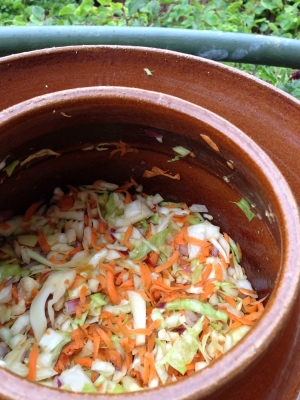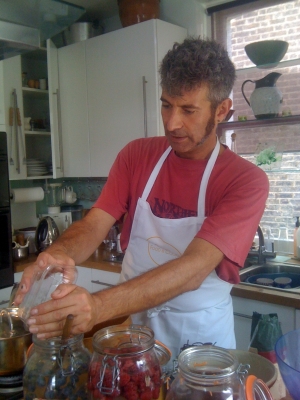
There is no mystery about fermenting vegetables. Its a traditional way to preserve food, and to use up winter vegetables to last through the cold, and to give added nutrition because of the beneficial enzymes that they produce.
Just take a white cabbage, and a selection of other suitable vegetables, such as carrots, onions, cauliflower, celery, onions and turnips, with garlic and ginger juice thrown in, and maybe a few chopped up red peppers for added spice and colour (without seeds though).
Grate the carrots and ginger, and thinly slice the other vegetables with a mandolin or by hand. Cauliflower should be quite small and so should the celery and turnips. You don’t have to have a fermenting crock like mine in the picture. Keep it simple with a kilner or mason jar. But once you have chopped you will need a wide mouth vessel to pound the vegetables in, with the added salt to break down the cell walls. This releases the vegetable water, which will allow the craut to be submerged and protected from mould whilst fermeting, and release the enzymes to break down the cell walls for easier digestion. The main benefit is the hugely increased load of beneficial bacteria that you are introducing into your gut.
No need to buy probiotics anymore! Get a whole lot more every day from your homemade ferments and notice the difference. Dr Mercola tested out a 6-8oz portion of sauerkraut for numbers of beneficial bacteria and found that it contained one tenth of the trillions of bacteria residing in your gut! That is a large portion, and more than you need at each meal. On this reckoning you will still get enough bacteria from less!
HOW MUCH SALT?
You must use a good quality salt, such as sea salt. The general rule is about two tablespoons per 3 lbs of vegetables, but I recommend you layer it as you chop, and taste as you go. Over time you will develop a instinct as to how much, so don’t be too put out if you get it wrong to start with. Adding whey means you can speed up the fermentation process, and add less salt.
Pound with your fists (quite hard work) until you have released enough water to cover the vegetables in the jar. A tip to keep the vegetables submerged in the brine is to cut a square piece of hard cabbage from the core and use the pressure of the lid to press down on it to keep the craut veggies under the water.
Make sure your jar is clean before introducing the sauerkraut, close the lid and place in your kitchen to ferment for a minimum of a week. For the first few days especially, open the lid for a few seconds once in a while to release the gasses that fermenting produces.
Taste after a week and transfer to the fridge or cold cellar if you are happy with the taste. You could leave some of it to ferment some more for an even more complex variety of flavours. The speed of fermentation will depend on the season and temperature in your kitchen.
Please let me know how you get on, and what changes in your health you notice. Check out the last post to read how it transformed my friend’s Irritable Bowel Syndrome in just three days. No wonder! Doesn’t it all make sense, using food in a traditional way to transform our health. Many people in the raw movement are discovering for themselves the transformative power of fermenting food.
The best book is Wild Fermentation by Sandor Katz Here he is in my kitchen in London, preparing for a Fermentation Workshop organised by the London Chapter of the Weston A Price Foundation in 2011. He left some bubbling away whilst he went off to Belgium, warning me that I might get spooked if some of the corks in the drinks blew. Well, they did, and all I can say is thank goodness I was forewarned. It sounded like a gun going off, and hit the ceiling. Nothing like this to remind you that you are dealing with LIVING FOODS!

preparing a fermented strawberry drink
